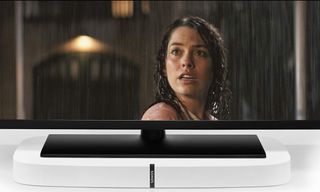Sonos Playbase review
If you can afford it, the Sonos Playbase offers almost everything you want in a soundbar, especially big sound and ease of use.
Why you can trust Tom's Guide

The Sonos Playbase is now discontinued, but when it launched Sonos' take on the soundbase (a soundbar intended to go under your TV stand) didn't disappoint.
With enormous bass, clear vocals and good ease of use, the Playbase even outdoes Sonos' impressive Playbar soundbar. If you have $700 and want a simple and great-sounding way to improve your TV's sound, the Playbase is among the best soundbars you can buy — at least, it was for a while.
Our Sonos Arc review rates Sonos's first soundbar with Dolby Atmos with an Editor's Choice award. The Arc is the company's next-gen home entertainment hardware with a refreshed design and all-new interior hardware. It sports eleven high-performance drivers, three tweeters and 8 custom elliptical woofers.
With the Sonos Arc on sale for $799, the Playbase is discontinued. But you can still get one refurbished, in which case you could find this Sonos Playbase review helpful in your purchasing decisions.
Design
The Playbase is on the small side for a premium soundbase. At 28.6 x 15 x 2.3 inches, it's less wide and deep than the 42 x 16.5 x 3.5-inch ZVox 770. Despite the smaller size, the Sonos has plenty packed in: six midrange drivers, three tweeters and one woofer, and each driver has its own amplifier.
Available in all white or all black, the Playbase doesn't exactly look like any other speaker in the Sonos line — several of the others feature gray elements like speaker grills — but its streamlined aesthetic will fit in well with an existing system.

The Playbase has minimal buttons and inputs. A single LED in the front provides status through color (white for on and green for mute, for example). There's also a touch-sensitive button for play and pause; areas to the right and left of the play button control the volume. Most of the functions are handled through the Sonos app, or, once you've set it up, your TV remote.

On the back, you'll find a place to plug in the power cord; an optional Ethernet port (the unit also does Wi-Fi, which could be enough unless you're streaming uncompressed audio); and an optical digital audio connection.
Unlike some higher-end soundbars, like the $700 Sony HT-NT5 and the $500 JBL SB450, the Playbase lacks HDMI. This may be an issue if your TV doesn't have as many HDMI inputs as you want, or if it doesn't support optical digital audio.
Performance
Sonos' Playbar has been the soundbar/base to beat in terms of movie and music performance for the past few years, and the Playbase exceeds it in all areas.

Bass performance was phenomenal for movies. When Doctor Strange's car crashed, the booms and thuds shook the floor — without a subwoofer. The bass also adds resonance to dialogue when you're watching movies or TV shows, making David's debates about his mental health in Legion easy to understand.
Sonos' Playbar has been the soundbar/base to beat in terms of movie and music performance for the past few years, and the Playbase exceeds it in all areas.
The orchestral arrangements in Doctor Strange swelled with bright horns and strings, while the crowd noise in the background of the UNC-Kentucky basketball game helped make the experience more engaging.
MORE: Best Bluetooth Speakers for Home or On-the-Go
The Playbase's strengths in home theater also translate to music. The bass breaks on Jidenna's "Long Live the Chief" rattled the room, while Rihanna's vocals on Future's "Selfish" sounded full and clear. The acoustic guitar on Big Star's "Thirteen" was sharp and realistic.
The unit filled my living room with sound, and it can get plenty loud for most viewing situations.
Setup
The Playbase is easy to set up and use — a key qualification for a good soundbase. It's intended to go under a TV stand, and not to be mounted on a wall. If you don't have a place to put it under the TV, the Playbar would be a better choice.
There's little to do to physically connect the Playbase to your TV: plug the speaker into the wall and connect the digital optical audio cable to your display. The rest of setup happens in Sonos' app. While there are quite a few screens to run through, from connecting to Wi-Fi to detecting any other Sonos speakers you have, most people should have no problem getting the system set up.
MORE: Sonos Play:5: Sound Centerpiece
The unit doesn't come with a remote, but it can learn how to use your existing TV's remote to control volume. You can also control the volume with the app or with the touch-sensitive buttons on the front of the unit.
To make the Playbase sound its best, you'll want to run Trueplay, Sonos' room-modeling effect. The speaker will play sounds and you walk around your room waving your phone around. It feels quite silly, but the sound improvements are well worth it. The bass was richer and the sound field wider after I ran Trueplay.
If the Playbase itself doesn't create an immersive enough experience, you can use Sonos' Play:1 speakers as left and right surrounds. You can also add a Sub, but only the most fanatical bass lovers will need more than what the Playbase outputs. And, of course, you can group together Sonos speakers in other rooms for multiroom sound.
Bottom Line
The Sonos Playbase impresses with its big bass, clear vocals and room-filling power. It's easy to set up and use, and sounds great whether you're playing movies, TV shows or music. In other words, it hits all the things you want out of a soundbase.

You pay for the privilege, though, and you can get good sound and more features on cheaper models. The $500 JBL SB450, for example, comes with three HDMI inputs, and the Playbase has none. But the SB450 and similar soundbars don't offer the overall experience that the Playbase does.
If you have other Sonos speakers and can afford the Playbase — and your TV supports optical digital audio — it will help complete your home sound system. If you already have a Playbar, you don't need to upgrade; the Playbase sounds better, but not enough to warrant a change.
Photo credit: Sonos
Sign up to get the BEST of Tom’s Guide direct to your inbox.
Upgrade your life with a daily dose of the biggest tech news, lifestyle hacks and our curated analysis. Be the first to know about cutting-edge gadgets and the hottest deals.

Michael Gowan is a freelance technology journalist covering soundbars, TVs, and wireless speakers of all kinds of shapes and sizes for Tom’s Guide. He has written hundreds of product reviews, focusing on sound quality and value to help shoppers make informed buying decisions. Micheal has written about music and consumer technology for more than 25 years. His work has appeared in publications including CNN, Wired, Men’s Journal, PC World and Macworld. When Michael’s not reviewing speakers, he’s probably listening to one anyway.
